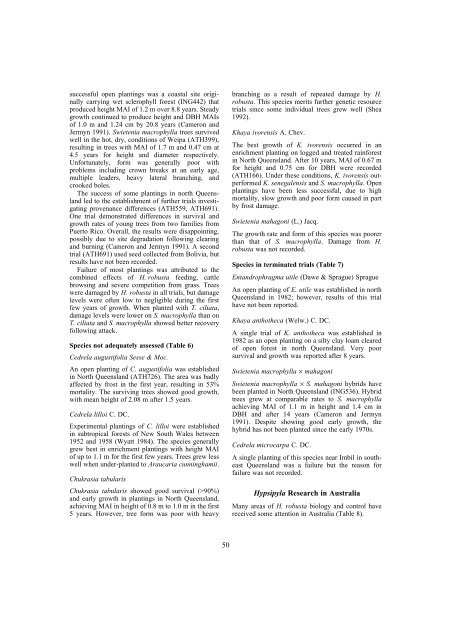Hypsipyla Shoot Borers of Meliaceae in Sri Lanka - Australian ...
Hypsipyla Shoot Borers of Meliaceae in Sri Lanka - Australian ...
Hypsipyla Shoot Borers of Meliaceae in Sri Lanka - Australian ...
You also want an ePaper? Increase the reach of your titles
YUMPU automatically turns print PDFs into web optimized ePapers that Google loves.
successful open plant<strong>in</strong>gs was a coastal site orig<strong>in</strong>ally<br />
carry<strong>in</strong>g wet sclerophyll forest (ING442) that<br />
produced height MAI <strong>of</strong> 1.2 m over 8.8 years. Steady<br />
growth cont<strong>in</strong>ued to produce height and DBH MAIs<br />
<strong>of</strong> 1.0 m and 1.24 cm by 20.8 years (Cameron and<br />
Jermyn 1991). Swietenia macrophylla trees survived<br />
well <strong>in</strong> the hot, dry, conditions <strong>of</strong> Weipa (ATH399),<br />
result<strong>in</strong>g <strong>in</strong> trees with MAI <strong>of</strong> 1.7 m and 0.47 cm at<br />
4.5 years for height and diameter respectively.<br />
Unfortunately, form was generally poor with<br />
problems <strong>in</strong>clud<strong>in</strong>g crown breaks at an early age,<br />
multiple leaders, heavy lateral branch<strong>in</strong>g, and<br />
crooked boles.<br />
The success <strong>of</strong> some plant<strong>in</strong>gs <strong>in</strong> north Queensland<br />
led to the establishment <strong>of</strong> further trials <strong>in</strong>vestigat<strong>in</strong>g<br />
provenance differences (ATH559, ATH691).<br />
One trial demonstrated differences <strong>in</strong> survival and<br />
growth rates <strong>of</strong> young trees from two families from<br />
Puerto Rico. Overall, the results were disappo<strong>in</strong>t<strong>in</strong>g,<br />
possibly due to site degradation follow<strong>in</strong>g clear<strong>in</strong>g<br />
and burn<strong>in</strong>g (Cameron and Jermyn 1991). A second<br />
trial (ATH691) used seed collected from Bolivia, but<br />
results have not been recorded.<br />
Failure <strong>of</strong> most plant<strong>in</strong>gs was attributed to the<br />
comb<strong>in</strong>ed effects <strong>of</strong> H. robusta feed<strong>in</strong>g, cattle<br />
brows<strong>in</strong>g and severe competition from grass. Trees<br />
were damaged by H. robusta <strong>in</strong> all trials, but damage<br />
levels were <strong>of</strong>ten low to negligible dur<strong>in</strong>g the first<br />
few years <strong>of</strong> growth. When planted with T. ciliata,<br />
damage levels were lower on S. macrophylla than on<br />
T. ciliata and S. macrophylla showed better recovery<br />
follow<strong>in</strong>g attack.<br />
Species not adequately assessed (Table 6)<br />
Cedrela augustifolia Sesse & Moc.<br />
An open plant<strong>in</strong>g <strong>of</strong> C. augustifolia was established<br />
<strong>in</strong> North Queensland (ATH726). The area was badly<br />
affected by frost <strong>in</strong> the first year, result<strong>in</strong>g <strong>in</strong> 53%<br />
mortality. The surviv<strong>in</strong>g trees showed good growth,<br />
with mean height <strong>of</strong> 2.08 m after 1.5 years.<br />
Cedrela lilloi C. DC.<br />
Experimental plant<strong>in</strong>gs <strong>of</strong> C. lilloi were established<br />
<strong>in</strong> subtropical forests <strong>of</strong> New South Wales between<br />
1952 and 1958 (Wyatt 1984). The species generally<br />
grew best <strong>in</strong> enrichment plant<strong>in</strong>gs with height MAI<br />
<strong>of</strong> up to 1.1 m for the first few years. Trees grew less<br />
well when under-planted to Araucaria cunn<strong>in</strong>ghamii.<br />
Chukrasia tabularis<br />
Chukrasia tabularis showed good survival (>90%)<br />
and early growth <strong>in</strong> plant<strong>in</strong>gs <strong>in</strong> North Queensland,<br />
achiev<strong>in</strong>g MAI <strong>in</strong> height <strong>of</strong> 0.8 m to 1.0 m <strong>in</strong> the first<br />
5 years. However, tree form was poor with heavy<br />
50<br />
branch<strong>in</strong>g as a result <strong>of</strong> repeated damage by H.<br />
robusta. This species merits further genetic resource<br />
trials s<strong>in</strong>ce some <strong>in</strong>dividual trees grew well (Shea<br />
1992).<br />
Khaya ivorensis A. Chev.<br />
The best growth <strong>of</strong> K. ivorensis occurred <strong>in</strong> an<br />
enrichment plant<strong>in</strong>g on logged and treated ra<strong>in</strong>forest<br />
<strong>in</strong> North Queensland. After 10 years, MAI <strong>of</strong> 0.67 m<br />
for height and 0.75 cm for DBH were recorded<br />
(ATH166). Under these conditions, K. ivorensis outperformed<br />
K. senegalensis and S. macrophylla. Open<br />
plant<strong>in</strong>gs have been less successful, due to high<br />
mortality, slow growth and poor form caused <strong>in</strong> part<br />
by frost damage.<br />
Swietenia mahagoni (L.) Jacq.<br />
The growth rate and form <strong>of</strong> this species was poorer<br />
than that <strong>of</strong> S. macrophylla. Damage from H.<br />
robusta was not recorded.<br />
Species <strong>in</strong> term<strong>in</strong>ated trials (Table 7)<br />
Entandrophragma utile (Dawe & Sprague) Sprague<br />
An open plant<strong>in</strong>g <strong>of</strong> E. utile was established <strong>in</strong> north<br />
Queensland <strong>in</strong> 1982; however, results <strong>of</strong> this trial<br />
have not been reported.<br />
Khaya anthotheca (Welw.) C. DC.<br />
A s<strong>in</strong>gle trial <strong>of</strong> K. anthotheca was established <strong>in</strong><br />
1982 as an open plant<strong>in</strong>g on a silty clay loam cleared<br />
<strong>of</strong> open forest <strong>in</strong> north Queensland. Very poor<br />
survival and growth was reported after 8 years.<br />
Swietenia macrophylla × mahagoni<br />
Swietenia macrophylla × S. mahagoni hybrids have<br />
been planted <strong>in</strong> North Queensland (ING536). Hybrid<br />
trees grew at comparable rates to S. macrophylla<br />
achiev<strong>in</strong>g MAI <strong>of</strong> 1.1 m <strong>in</strong> height and 1.4 cm <strong>in</strong><br />
DBH and after 14 years (Cameron and Jermyn<br />
1991). Despite show<strong>in</strong>g good early growth, the<br />
hybrid has not been planted s<strong>in</strong>ce the early 1970s.<br />
Cedrela microcarpa C. DC.<br />
A s<strong>in</strong>gle plant<strong>in</strong>g <strong>of</strong> this species near Imbil <strong>in</strong> southeast<br />
Queensland was a failure but the reason for<br />
failure was not recorded.<br />
<strong>Hypsipyla</strong> Research <strong>in</strong> Australia<br />
Many areas <strong>of</strong> H. robusta biology and control have<br />
received some attention <strong>in</strong> Australia (Table 8).

















